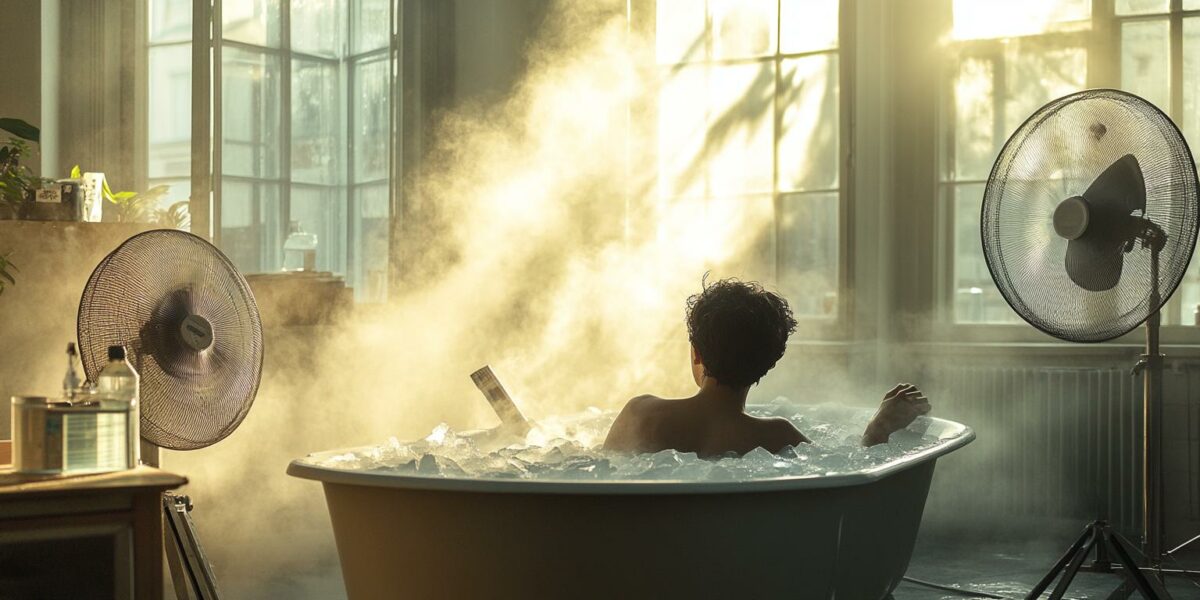Heat Domes and Home Adaptations
The intense heat dome of 2021 in the Pacific Northwest was a wake-up call for many. Rose, 62, found herself battling the extreme conditions with makeshift solutions, like filling a bathtub with ice to stay cool. The scorching temperatures reached 120F (49C), a stark reminder of the climate crisis’s immediate impact.
Recognizing the need for better preparation, Rose acquired 2-inch thick insulation boards to create a cooler refuge in her home. She also added a deep bathtub as part of her strategy to combat future heatwaves. Such adaptations highlight the creative measures individuals are taking to cope.
The ‘heat dome’ was just one manifestation of increasing extreme weather events, including hurricanes, wildfires, and floods. These events are becoming more frequent and intense, forcing individuals to rethink and modify their living spaces for survival.
For Rose, the experience underscored the urgent reality of climate change. She remarked on the terrifying ordeal, saying, “Both of us could have died … It’s very, very scary.” This sentiment resonates with many facing similar challenges.
Wildfire Risks and Community Challenges
In Denver, Colorado, Shannon Tucker faced a different threat: wildfires. After a warning from a gutter cleaner, she realized her yard debris was a potential fire hazard. This realization led her to regularly clean gutters and install air purifiers and solar panels at home.
States like Texas, California, and Colorado are experiencing worsening wildfires. Tucker, working in tech, noted the fires’ increasing proximity to Denver and the frequent air quality alerts. She recalls a time when such alerts were rare.
Adapting to these risks, Shannon implemented several measures:
- Gutter cleaning every six months
- Yard debris removal
- Installation of air purifiers and solar panels
Despite these efforts, Tucker is frustrated. She acknowledges that personal actions alone can’t solve the climate crisis, and collective action is essential for broader change.
Hurricane Preparedness in Texas
In Corpus Christi, Texas, Roxane Rolingson faced the increasing threat of hurricanes. Traditionally using plywood to protect her windows, she recently invested $20,000 in stainless-steel screens, allowing her to delay preparations until the last minute when a hurricane approaches.
Rolingson recognizes the financial burden of such protective measures, admitting, “I’m a middle-retired person, so I can afford that. Lots of people [affected by the climate crisis] can’t.” Her story highlights the economic disparities in climate preparedness.
Hurricane seasons seem longer and more severe than before, further prompting residents to invest in robust home defenses. These changes are essential for safety but often come with high costs.
Even with her preparations, Rolingson remains cautious, understanding that natural disasters are becoming an unpredictable norm. She stands ready to activate her shutters and evacuate if necessary.
Storms and Economic Inequality in Philadelphia
In Philadelphia, Rob Kirsch has witnessed increasingly violent storms. His neighborhood, filled with old trees, poses a constant threat during such weather, as branches can easily crash down, causing significant damage.
Kirsch has spent thousands on home improvements, including attic insulation and basement flood-proofing, necessary due to his family’s health needs. These modifications have provided some protection, but the costs are steep.
Despite his efforts, Kirsch acknowledges the financial barriers many face. He notes, “There’s a lot of poverty here. A lot of people are impacted by not having the sources to upgrade their houses.” This disparity leaves many vulnerable to the harsh effects of climate change.
As Kirsch considers replacing his slate roof, he remains acutely aware of the economic divide, knowing many cannot afford such necessary adaptations, despite the growing risks of severe weather.



OliviaCelestia8
Rose and Shannon are like modern-day climate warriors, turning their homes into fortresses. But seriously, are these strategies enough against such severe weather? 🤔
Toby
It’s frustrating that people have to spend so much money just to feel safe in their homes. What can be done to make these solutions more affordable?
IsabellaRaven8
Can someone explain what exactly a heat dome is? I’m not sure I understand how it affects climate patterns.
camila9
Why are hurricane screens so expensive! $20,000 is more than some people make in a year.
aidenamethyst
Thanks for sharing these stories. It’s a wake-up call for those of us who haven’t yet faced such extremes. Stay safe everyone!
jasper2
It’s inspiring to see people like Rose and Shannon taking action, but it feels like a band-aid on a bigger problem. How do we push for systemic change?
josephtranquility
Wow, ice baths in the living room! 😂 That’s one way to stay cool! How effective do you think they really are though?